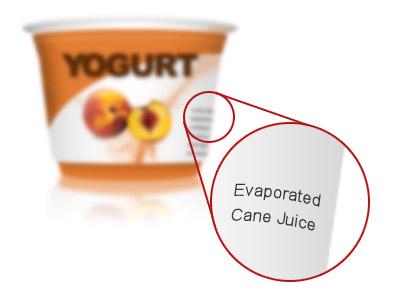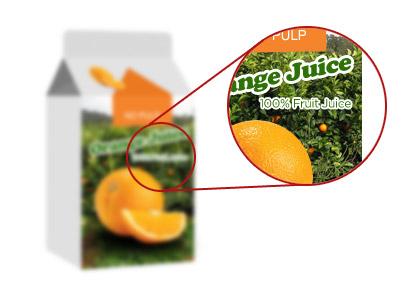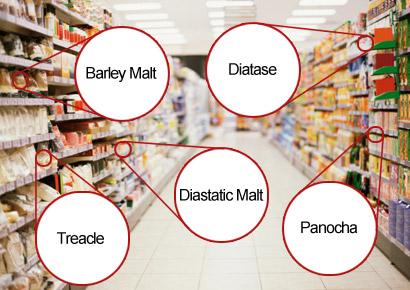Previously discussed, sugar is the bane of our existence. “Can’t live with it, can’t live with out it”. Since almost everything either has sugar in it or breaks down in our body (carbohydrates) to form sugar, we should avoid excess sugar intake when ever we can. I provide the following information about sugar as a FYI blog. This information comes from Prevention.com and a recent article written by Mandy Oaklander called, “10 Sneaky Names for Sugar“. All of the following images are from the same article. If you only read one, become enlightened, read the first one. . – jughandle
1. Sucrose
What’s the anatomy of a sugar? Let’s start with table sugar, one of the most common. The scientific name is sucrose: That’s half glucose (starch) and half fructose (sweetness). You might also know it by “cane sugar,” which is 100% sucrose.
All of your organs are capable of metabolizing glucose, unfortunately, fructose is metabolized by your liver alone. Robert Lustig, MD, professor of pediatrics at the University of California, San Francisco, in his forthcoming book Fat Chance: Beating the Odds Against Sugar, Processed Food, Obesity, and Disease.
In other words, fructose taxes your liver. And it’s in every caloric sweetener, from white sugar, to cane sugar, to beet sugar, to agave nectar. It also pops up on food labels by itself.
Published October 2012, Prevention
Updated October 2012
2. Evaporated Cane Juice
Sounds healthier, right? Don’t believe the babble. Evaporated cane juice is little more than a dressed-up name for straight-up sugar.
In October 2009, the FDA issued a guidance statement about the term, evaporated cane juice.
The FDA’s current policy is that the term‘evaporated cane juice’ should not be associated with sweeteners derived from sugar cane syrup.
They believe that the term ‘evaporated cane juice’, suggests that the sweeteners are juice,” the guidance says. But in reality, evaporated cane juice isn’t even a liquid.
The FDA recommendations aren’t binding. Still, the yogurt company Chobani is under legal fire for its simultaneous use of “evaporated cane juice” and its claim of “no sugar added” products, reports Food Navigator. The lawsuit, brought by a California woman, accuses the company of violating federal law.
Published October 2012, Prevention
Updated October 2012
3. Agave Nectar
Another “health” food favorite, agave nectar, touted as a natural sugar and used in natural baked goods, around the globe.
Agave nectar is higher in fructose than cane sugar.
In fact, says Andrew Weil, MD, founder and director of the Arizona Center for Integrative Medicine at the University of Arizona,
agave is 85% fructose. Agave’s probably one of the worst, Dr. Weil says. Not only is it not healthier for you, but it also doesn’t even contain more antioxidants or minerals than other types.
However, it does have a lower glycemic load than other sweeteners, so it causes a less drastic spike in blood sugar. It is so sweet that you may use less of it.
Published October 2012, Prevention
Updated October 2012
4. Fruit Juice Concentrate
No matter how healthy your juice looks, chances are good that added fruit juice concentrate is in there.
Check labels of juice, flavored yogurt and any other processed food for grape, apple or any other kind of fruit juice concentrate: It’s all too often there. Also look for it in snack bars, applesauce, and other fruity edibles.
Concentrate is formed when the water is removed from fruit juice. What’s left? We’ll give you one guess. Yup, sugar.
Published October 2012, Prevention
Updated October 2012
5. 100% Fruit Juice
But what about an organic, natural, no-sugar-added, 100% fruit juice? No concentrate, no problems, right? Sorry to ruin your breakfast, but you might as well go ahead and skip this OJ and have a Snickers.
Whole fruit is good for you, says Dr. Lustig, because it contains lots of fiber. In juice form, which is devoid of fiber, sugar’s sugar—even if you juice it yourself, straight from fresh fruit. “It’s all the same,” Lustig writes of sugar’s many names and forms in his forthcoming book, Fat Chance. “The vehicle is irrelevant; it’s the payload that matters.” By this definition, your 100% orange juice is worse for you than soda: The former contains 5.8 teaspoons of sugar per cup, while soda contains 5.4.
Published October 2012, Prevention
Updated October 2012
6. High Fructose Corn Syrup (HFCS)
Study after study has shown that high fructose corn syrup, made from processed (and usually genetically modified) cornstarch, is technically no different from sucrose. But some research shows that HFCS generates a higher blood fructose level, which could have negative metabolic consequences. High fructose corn syrup has been linked to obesity and diabetes.
In 2010, corn refiners petitioned the FDA for permission to start calling HFCS “corn sugar.” They were turned down.
Published October 2012, Prevention
Updated October 2012
7. The -Oses
Watch out for anything –ose, lest you sugar overdose. You’ve met sucrose, glucose, and fructose, but did you know galactose, maltose, dextrose, and lactose? They’re all sugars—some of which occur naturally but can be processed in a lab, too—that can be added to processed foods. Eater beware.
Published October 2012, Prevention
Updated October 2012
8. Blackstrap Molasses
If you were alive in the 1880s, then congratulations! Not only are you at least 132 years old, but you remember when blackstrap molasses was the No. 1 sweetener in the United States. This natural sweetener is sugar too, but, like most things in the olden days, it was better for you. This viscous syrup contains vitamin B6, manganese, calcium, copper, and selenium. And just one tablespoon of molasses has about 4 times the iron as a 3-ounce white chicken breast, according to the American Diatetic Association’s Complete Food & Nutrition Guide.
Check out the other antioxidant-rich sugars, including maple syrup, here.
Published October 2012, Prevention
Updated October 2012
9. Organic Brown Rice Syrup
With a name like that, you’ve got to deserve your health halo, right? Not according to a recent Dartmouth College study published in Environmental Health Perspectives. Brown rice sugar is shilled to the natural food market as a “healthier” alternative to high fructose corn syrup.
Not only is it still sugar, but it may also be contaminated with arsenic.
The study found high levels of arsenic, which is linked to cancer and chronic diseases in processed foods sweetened with organic brown rice syrup.
We’re talking energy bars, cereal bars, and even baby formula. (To protect yourself, you’ll want to take a look at our list of 10 Ways to Avoid Arsenic In Your Food.)
Published October 2012, Prevention
Updated October 2012
10. …and so many more
Barley malt, golden syrup, diastatic malt, diastase, treacle, panocha, sorghum syrup—we couldn’t get to all of you, but that doesn’t mean you’re not lurking in our processed foods, too.
Besides scouring ingredients lists, the key to monitoring your sugar is determining just how much each serving contains. How? Check the nutrition label for total grams of sugar, and divide that by four (each teaspoon of sugar is equal to 4 grams.) That’s how many teaspoons of sugar are really in your cookie, your ketchup, and your no-sugar-added fruit juice.
Published October 2012, Prevention
Updated January 10, 2018











